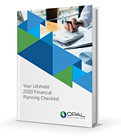Do Alternative Investments Deserve a Spot in Your Portfolio?
By Gino Carollo | May 25, 2022Long-term investing typically requires adaptability. What matters most is staying invested over the long haul, but a variety of factors can crop up along the way and nudge you to tweak your investment strategy. Inflation is one such concern. In February 2022, the consumer price index spiked 7.9% from a year earlier—the largest 12-month increase since 1982. Ongoing supply chain issues, labor shortages and the Russia-Ukraine conflict are only throwing fuel on the fire.
Investors may not have control over these things but exploring nontraditional assets in the face of such headwinds could prove valuable. This is where alternative investments come in. They venture beyond traditional asset classes and can help position your portfolio for long-term growth in an uncertain future.

Reimagining the 60/40 Portfolio
More and more investors have been rethinking the 60/40 portfolio. This long-held rule of thumb suggests allocating 60% of your portfolio to stocks and 40% to bonds. It’s designed to mitigate risk and has historically performed well. From 2010 to 2020, the average annualized return for this kind of portfolio was around 10%, according to investment research company Morningstar. However, the outlook going forward may call for a different approach.
The S&P 500 gained nearly 27% in 2021, but this year’s consensus estimates are only in the high single digits. Regarding bonds, most pay out a lower fixed interest rate. Demand goes up when interest rates fall, but bonds become less attractive in a rising-rate environment. The Federal Reserve recently raised interest rates for the first time in three years and signaled that we can expect more of the same going forward.
When taken together, the 60/40 portfolio may not be able to provide the returns and diversification it has in the past. It’s a primary reason we’re helping more investors navigate alternative investments. It’s especially relevant since inflation doesn’t appear to be slowing down. It’s pushing folks to think differently about their portfolios and retirement plans. Alternative investments may offer a different way of building long-term wealth against the backdrop of inflation.
Exploring Alternative Investments
Alternative investments take many forms. Risk is a common thread, but it also creates an opportunity for greater returns. If utilized, it’s probably wise to sprinkle them throughout your investment portfolio, as opposed to going all in. Doing so may help you keep pace with inflation and provide balance alongside safer investments. Below are some alternative investments that may be worth considering.
1. Hedge Funds
High-net-worth investors can look to hedge funds as a nontraditional investment. Most funds will require you to be an accredited investor, signifying that you meet certain criteria to help demonstrate financial stability and the ability to withstand potentially higher risks and liquidity constraints. Hedge funds are actively managed and designed to maximize investor returns while minimizing risk.
Regardless of whether the stock or bond market climbs or drops, managers can hedge themselves—by going long if they foresee a market rise or shorting if they anticipate a drop. These hedging strategies are meant to reduce risk, but they aren’t entirely risk-free. Most use some degree of leverage to enhance returns, which can certainly dial up risk. Fees also tend to be on the higher side, and investors should be prepared for a material financial commitment. However, hedge funds typically have wider investment latitude and are only limited by their mandate.
There are many types of hedge funds. Some focus on reducing risk, while others aim to maximize returns. A hedge fund manager’s experience and skill level can make or break the success of a strategy.
2. Private Equity
The number of publicly traded companies have dropped by nearly one-third since the 1990s. Costs and regulatory hurdles associated with going public are some of the reasons, but a major contributing factor is the growth of alternative funding options for private businesses. This includes private equity funds. McKinsey reports that from 2010 to 2020, the size of the private equity market has grown from $2.4 trillion to $6.5 trillion. What’s more, according to data from Cambridge Associates, private equity produced average annual returns of 10.48% over the 20-year period ending in June 2020—the S&P 500, on the other hand, returned 5.91%.
Private equity investments allow investors to participate in the growth of businesses as they would with publicly traded companies, however the businesses are privately owned. This means they don’t have a value that trades daily in the stock market. This might be attractive to investors who don’t want to worry about daily market gyrations impacting their investment portfolio.
One of the trade-offs of owning a private equity fund is that investors are typically required to commit to investment periods of seven to 12 years. Investors should evaluate the investment opportunity to make sure the potential return is significant enough to offset the lack of liquidity.
3. Private Credit
If private equity is the private version of public company investing, private credit is the private version of bond investing. While private equity allows you to invest in and own a private company, private credit allows an investor to make loans to a private company. Investors are compensated for limited liquidity terms with potentially higher interest rates—plus the potential for appreciation of the underlying loans, depending on the fund strategy and a variety of economic and business factors.
4. Private Real Estate
This can include everything from purchasing a rental property to buying and flipping fixer-uppers. Those who aren’t keen on being a landlord or prefer not to buy actual property can invest in both public and private real estate investment trusts (REITs). They let you buy into companies that own residential and/or commercial real estate portfolios. While you can buy a publicly traded REIT through any brokerage firm, access to private real estate investment trusts is somewhat limited. However, they have the potential to deliver excess returns of publicly traded REITs.
Depending on your situation, incorporating alternative investments into your portfolio might be a wise decision as we move through potential challenges this year. When done right, they can help provide diversification and potentially give you a leg up over inflation, though they don’t come without risk. Talk to an experienced financial advisor who can help guide you toward investments that align with your overall financial plan. Connect with Opal Wealth Advisors today to see what that might look like for you.
Be a Smart Investor
Stay up-to-date with industry-leading information and news delivered straight to your inbox.
Get our timely insights delivered to your inbox (Blog)
Please remember that past performance may not be indicative of future results. Different types of investments involve varying degrees of risk, and there can be no assurance that the future performance of any specific investment, investment strategy, or product (including the investments and/or investment strategies recommended or undertaken by Opal Wealth Advisors, LLC [“OWA]), or any non-investment related content, made reference to directly or indirectly in this commentary will be profitable, equal any corresponding indicated historical performance level(s), be suitable for your portfolio or individual situation, or prove successful. Due to various factors, including changing market conditions and/or applicable laws, the content may no longer be reflective of current opinions or positions. Moreover, you should not assume that any discussion or information contained in this commentary serves as the receipt of, or as a substitute for, personalized investment advice from OWA. OWA is neither a law firm, nor a certified public accounting firm, and no portion of the commentary content should be construed as legal or accounting advice. A copy of the OWA’s current written disclosure Brochure discussing our advisory services and fees continues to remain available upon request or at www.opalwealthadvisors.com. Please Remember: If you are a OWA client, please contact OWA, in writing, if there are any changes in your personal/financial situation or investment objectives for the purpose of reviewing/evaluating/revising our previous recommendations and/or services, or if you would like to impose, add, or to modify any reasonable restrictions to our investment advisory services. Unless, and until, you notify us, in writing, to the contrary, we shall continue to provide services as we do currently. Please Also Remember to advise us if you have not been receiving account statements (at least quarterly) from the account custodian.



